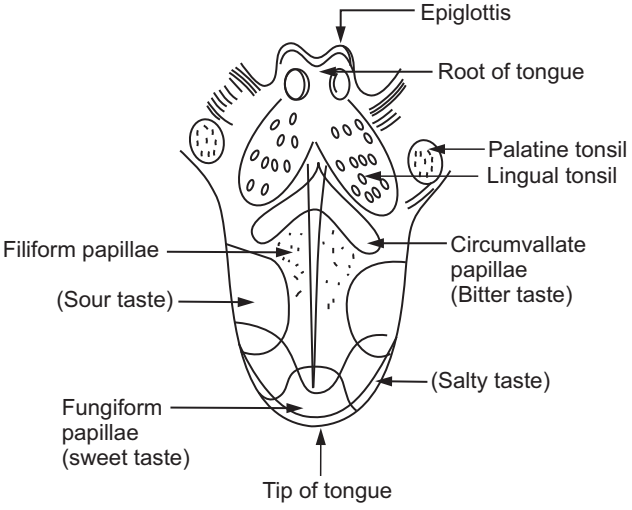Aim: To examine the different types of taste.
Requirements: Sucrose solution (10%), sodium chloride solution (15%), acetic acid solution (1%), Ipecac solution (0.1%), dropper bottles, a hand lens, cotton swabs, four cards with sweet, salt, sour and bitter printed on them.
Principle: The primary taste sensations include sweet, sour, salty, and bitter. The taste (also called gustatory) receptors responsible for the sensation of these tastes are located in the taste buds of different regions of the tongue. The sweet taste is experienced near the tip of the tongue, salt on the sides and top, bitter in the posterior part, and sour sensation in between these areas.
The perception of taste occurs through the pathway summarized below:
- Gustatory receptors get activated upon receiving chemical stimuli from the food after dissolving in saliva.
- The activated gustatory receptors conduct the impulse via the facial nerve (VII) from the anterior 2/3rd of the tongue; glossopharyngeal nerve (IX) from the posterior 1/3rd of the tongue and vagus (X) from the throat and epiglottis.
- The impulses are conducted to medulla oblongata and project to the limbic system, hypothalamus, and thalamus.
- The nerve fibers from the thalamus extend to the primary gustatory area in the parietal cerebral cortex and result in the perception of taste.
Procedure:
1. Select a healthy human subject.
2. Ask the subject to protrude his tongue. The tip of the tongue may be held with gauze if required.
3. Examine and identify the areas on the tongue having large concentrations of papillae and taste buds. Locate the fungiform and circumvallate papillae as shown in the figure.
4. Ask the subject to rinse the mouth with water and dry it with gauze. Moisten a swab with a few drops of sugar solution and apply it to the tip of the tongue. Ask him/her to indicate, the taste experienced with the help of printed cards without withdrawing the tongue.
5. Repeat the procedure with all remaining solutions by applying them one by one, on the sides near the tip, the anterior 2/3rd, and the posterior 1/3rd of the tongue. Care must be taken to avoid spreading of test solution across the midline.

6. Record the results as per taste perceived, and grade the intensity of taste sensation as per the following scale:
Intense (++++), moderate (+++), mild (++), slight (+), absent (0).
Observation table:

Make sure you also check our other amazing Article on : Tidal Volume and Vital Capacity
